Predictions & Data for this entry
| Model: stx | climate: A, B, C, D | migrate: | phylum: |
| COMPLETE = 4.5 | ecozone: TH, TP, TA, TN | food: bxM, xiO | class: |
| MRE = 0.071 | habitat: 0iTa, 0iTs, 0iTg | gender: Dg | order: |
| SMSE = 0.010 | embryo: Tv | reprod: O | family: |
Zero-variate data
| Data | Observed | Predicted | (RE) | Unit | Description | Reference |
|---|---|---|---|---|---|---|
| tg | 20 | 17.65 | (0.1177) | d | gestation time | AnAge |
| tx | 22 | 21.93 | (0.003041) | d | time since birth at weaning | AnAge |
| tp | 26 | 25.42 | (0.02242) | d | time since birth at puberty | BrusSchi2015 |
| Li | 10.2 | 10.2 | (0.0001822) | cm | ultimate body length | IJssSche1977 |
| Wwb | 1 | 1.027 | (0.02659) | g | wet weight at birth | BerrBron1992 |
| Wwp | 10 | 10.17 | (0.01738) | g | wet weight at puberty | Laur1946 |
| Wwi | 50 | 46.46 | (0.07073) | g | ultimate wet weight | WeinWalf1986 |
| Ri | 0.09589 | 0.09464 | (0.01305) | #/d | maximum reprod rate | AnAge |
| xi_WE | 20.09 | 22.78 | (0.1337) | kJ/g | whole-body energy density (no reprod buffer), in dry weight | Stud1979 |
Uni- and bivariate data
| Data | Figure | Independent variable | Dependent variable | (RE) | Reference |
|---|---|---|---|---|---|
| tW100 | 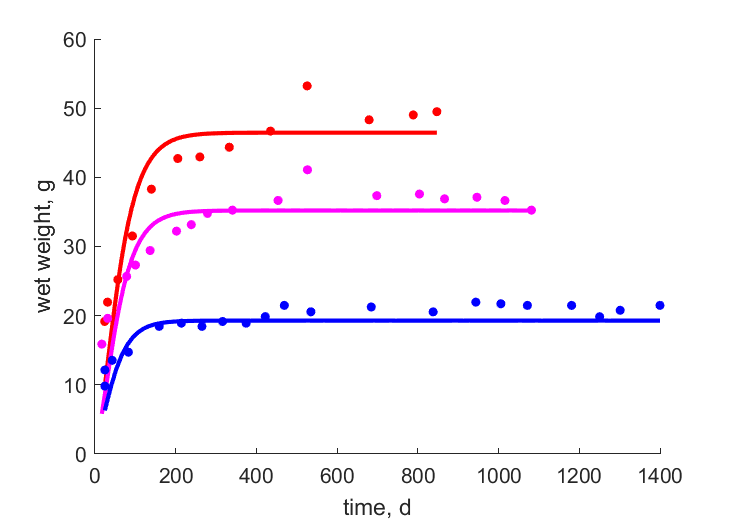 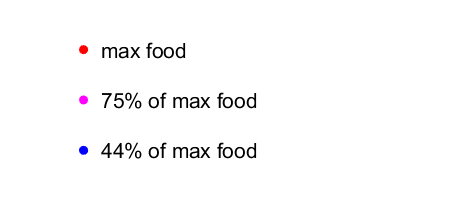 | time | wet weight | (0.09246) | WeinWalf1986 |
| tW75 |   | time | wet weight | (0.07709) | WeinWalf1986 |
| tW44 |   | time | wet weight | (0.09311) | WeinWalf1986 |
| tS100 | 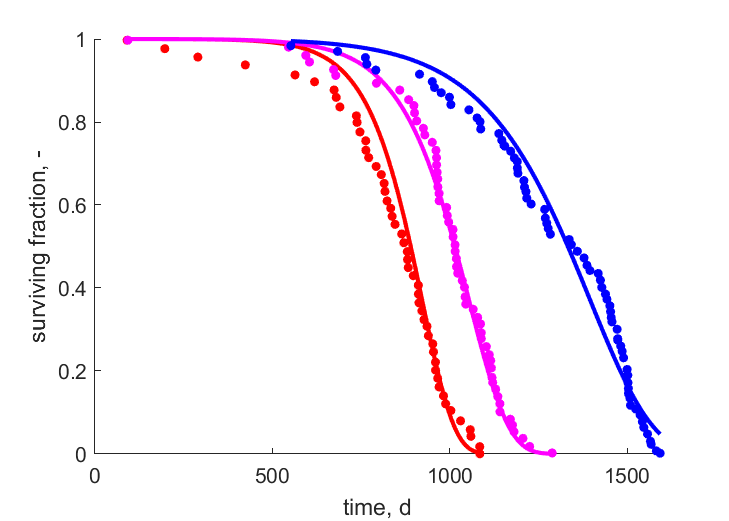 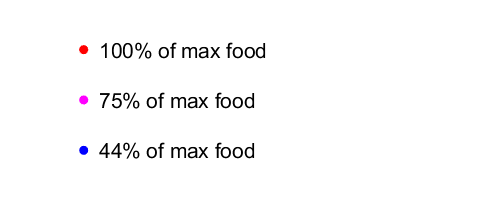 | time | surviving fraction | (0.1049) | WeinWalf1986 |
| tS75 |   | time | surviving fraction | (0.05574) | WeinWalf1986 |
| tS44 |   | time | surviving fraction | (0.101) | WeinWalf1986 |
| tWm | 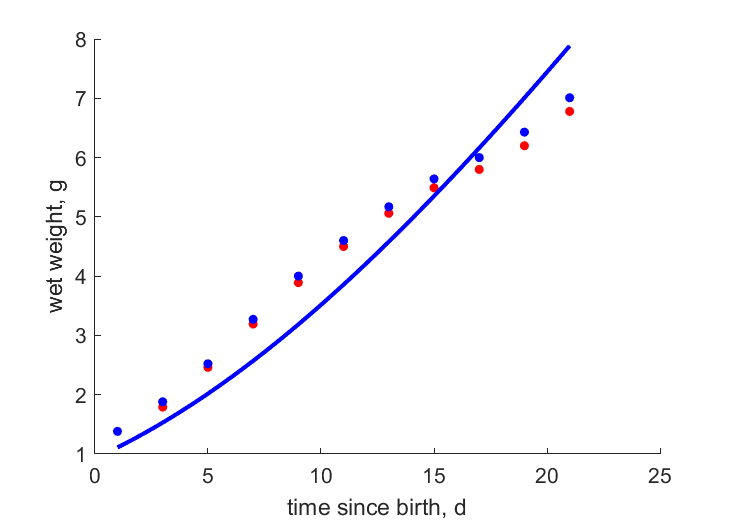  | time since birth | wet weight | (0.1255) | Gate1925 |
| tWf |   | time since birth | wet weight | (0.1228) | Gate1925 |
| WJO | 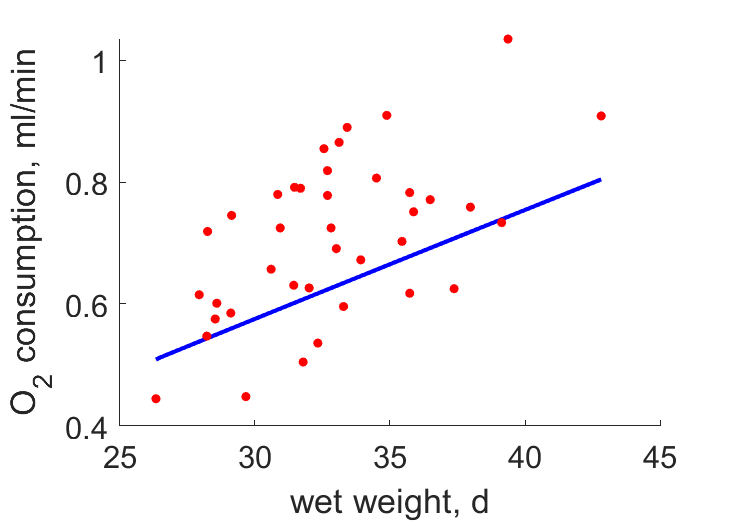 | wet weight | O_2 consumption | (0.1552) | SelmLums2001 |
| tW1 | 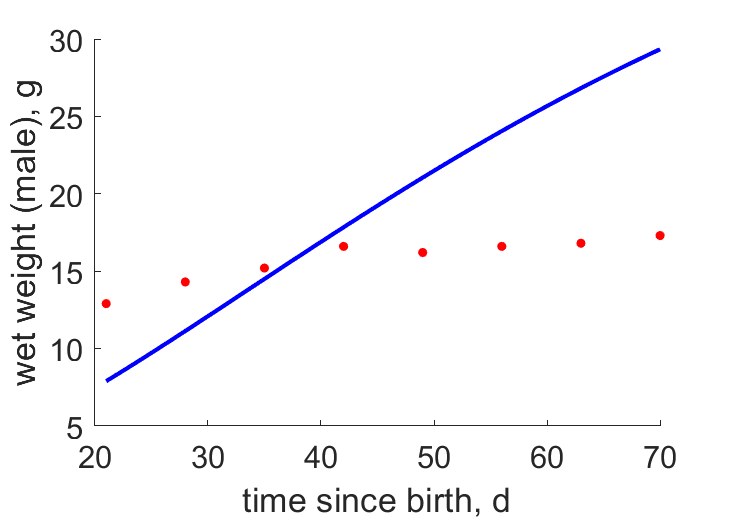 | time since birth | wet weight (male) | (2.827) | IshiHata2005 |
| tW2 |  | time since birth | wet weight (male) | (0.06717) | HallFerg2002 |
| tW3 |  | time since birth | wet weight | (0.1723) | BakeLiu1993 |
| tW_e | 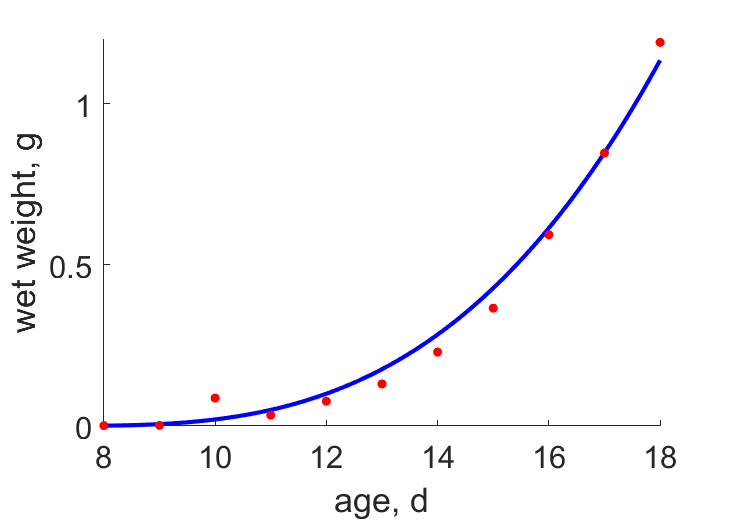 | age | wet weight | (0.09863) | MacDAlle1927 |
Pseudo-data at Tref = 20°C
| Data | Generalised animal | Mus musculus | Unit | Description |
|---|---|---|---|---|
| v | 0.02 | 0.03158 | cm/d | energy conductance |
| kap | 0.8 | 0.961 | - | allocation fraction to soma |
| kap_R | 0.95 | 0.95 | - | reproduction efficiency |
| p_M | 18 | 954.7 | J/d.cm^3 | vol-spec som maint |
| k_J | 0.002 | 0.002 | 1/d | maturity maint rate coefficient |
| kap_G | 0.8 | 0.7993 | - | growth efficiency |
Discussion
- version 20151106: V0 morphic feeding (ie contant feeding irrespective of size) is assumed for growth and survival data from WeinWalf1986
- version 20180502: isomorphic feeding used for WeinWalf1986
- version 20180502: t_0 is fixed and not estimated
- version 20180502: addition of datasets: Ww-JO SelmLums2001, t-Ww by BakeLiu1991, Gate1925, IshiHata2005, HallFerg2002
- version 20180502: the growth curve by IshiHata2005 weight zero, because of the strange morphology with respect to the other curves
- version 20180502: the fit could be improved in some of the growth cuves by assuming higher f during the milking stage.
- version 20180502: MacDAlle1927 state that males and females differ, but we did not find data to support this. Hence this entry assumes same parameters for males and females.
Facts
- This entry is discussed in LeeuKelp2002 (Ref: LeeuKelp2002)
- Time from conception to start of development (T_0) is taken to be 7.2 d (Ref: MacDAlle1927)
- Male and female mice differ in development over the course of their lives. (Ref: MacDAlle1927)
- Female mice can resorbe their fetuses, maybe even a third of them (Ref: Laur1946)
- Equal weight at birth for males and females, some light differences in growth between males and females become apparent after birth. (Ref: Gate1925)
Bibliography